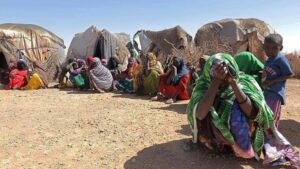The Sitti Zone of Ethiopia’s Somali Region is on the brink of a catastrophic humanitarian disaster. Communities are battling severe famine, a cholera outbreak, and state-mediated conflict—a deadly combination that has devastated livelihoods and displaced thousands.
Internally displaced people (IDPs), host communities, and pastoral families face worsening conditions amid what humanitarian observers describe as a deliberate policy of neglect and deprivation.
Famine and Displacement
The western Sitti Zone, particularly the areas of Garba-Issa, Undhufo, and Adaytu, has been hardest hit. The combination of prolonged drought and state-driven marginalization has left entire communities in famine conditions.
- Livelihoods Destroyed: Pastoral families have lost nearly all their livestock due to drought and restricted grazing access.
- Forced Displacement: Thousands of Somali civilians have been evicted from their lands by Afar militias, supported by elements of the Ethiopian National Defense Force (ENDF).
- Burned Towns: Key market centers, including Garba-Issa, Undhufo, and Adaytu, were reportedly burned to the ground—cutting off food and market access for surrounding villages.
Local leaders report that starvation is being used as a weapon of war, as the Ethiopian army and allied militias block humanitarian corridors and food distribution routes.
Health Emergency: Cholera and Malnutrition
The crisis is compounded by the collapse of health and sanitation services. A widespread cholera outbreak has spread rapidly across multiple districts, killing dozens and infecting hundreds.
According to the UN Office for the Coordination of Humanitarian Affairs (OCHA) multi-cluster assessment (January 2024):
- 44% of IDP sites were severely affected by drought.
- 25% reported outbreaks of cholera and other communicable diseases.
- 31% were directly impacted by armed conflict.
- 55% of sites reported food insecurity, while 27% reported severe price inflation on basic food items.
The hardest-hit districts include Erer, Gablalu, and Dembel, with villages such as Badiweyn, Aska, Dagaray, Gadweyn, Hoore, and Fadato reporting catastrophic losses of life.
In Hoore and Fadato, the cholera outbreak has spiraled out of control. Contaminated water sources, lack of sanitation, and overcrowded IDP camps have led to hundreds of preventable deaths.
Human Rights Violations
Beyond the humanitarian tragedy lies a deeper crisis of systematic human rights abuse.
Reports from local communities, activists, and aid workers indicate:
- Targeted ethnic violence and forced displacement of Somali civilians from strategic areas.
- Destruction of property and farmland by state-aligned forces.
- Blockade of humanitarian aid and denial of food assistance to displaced populations.
- Media blackout and restriction of access to affected zones for journalists and human rights monitors.
The Somali population of Sitti Zone continues to face political and economic marginalization, lack of infrastructure, and denial of essential services—all in violation of Ethiopia’s federal constitution and international humanitarian law.
Call for Immediate Action
Humanitarian agencies and rights organizations are urged to:
- Establish independent investigations into the atrocities and forced displacements in Sitti Zone.
- Demand unrestricted humanitarian access for aid groups, journalists, and international observers.
- Hold Ethiopian federal and regional authorities accountable for violations of human rights and the weaponization of hunger.
The situation in Sitti Zone is a humanitarian emergency that requires urgent intervention before it escalates further into mass death and irreversible famine.
Sources:
- UN OCHA Multi-Cluster Needs Assessment, January 2024
- Field reports from community leaders and humanitarian monitors
- Local testimonies from IDPs in Garba-Issa, Adaytu, and Erer

